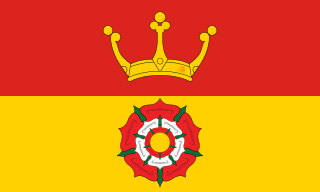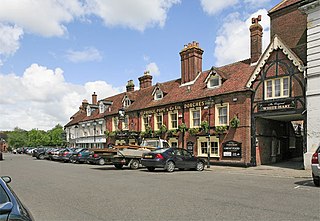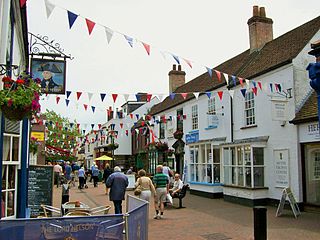Related Research Articles

Daniel Defoe was an English writer, trader, journalist, pamphleteer and spy. He is most famous for his novel Robinson Crusoe, published in 1719, which is claimed to be second only to the Bible in its number of translations. He has been seen as one of the earliest proponents of the English novel, and helped to popularise the form in Britain with others such as Aphra Behn and Samuel Richardson. Defoe wrote many political tracts, was often in trouble with the authorities, and spent a period in prison. Intellectuals and political leaders paid attention to his fresh ideas and sometimes consulted him.

Hampshire is a ceremonial and non-metropolitan county in western South East England on the coast of the English Channel. Home to approximately 1.9 million people, Hampshire is the 5th-most populous county in England. Its largest settlements are the cities of Southampton and Portsmouth. The county town is Winchester. It is bordered by Berkshire to the north, Surrey to the north-east, Wiltshire to the north-west, West Sussex to the south-east, and Dorset to the south-west. The county contains two national parks: the New Forest and part of the South Downs, which together cover 45 per cent of Hampshire.

Ringwood is a market town in south-west Hampshire, England, on the River Avon close to the New Forest, northeast of Bournemouth and southwest of Southampton. It was founded by the Anglo-Saxons, and has held a weekly market since the Middle Ages.

Hythe is a town near Southampton, Hampshire, England. It is located by the shore of Southampton Water, and has a ferry service connecting it to Southampton. Hythe has a small shopping area, a pier, and a marina for yachts.

The New Forest is one of the largest remaining tracts of unenclosed pasture land, heathland and forest in Southern England, covering southwest Hampshire and southeast Wiltshire. It was proclaimed a royal forest by William the Conqueror, featuring in the Domesday Book.

Totton and Eling is a civil parish in Hampshire, England, with a population of about 28,100 people. It contains the town of Totton and is situated between the eastern edge of the New Forest and the River Test, close to the city of Southampton but outside the city boundary; the town is within the New Forest non-metropolitan district. Surrounding towns and villages include Ashurst, Marchwood, Cadnam and Ower.

Lyndhurst is a large village and civil parish situated in the New Forest National Park in Hampshire, England. Serving as the administrative capital of the New Forest, it is a popular tourist attraction, with many independent shops, art galleries, cafés, museums, pubs and hotels. The nearest city is Southampton, about nine miles (14 km) to the north-east. As of 2001 Lyndhurst had a population of 2,973, increasing to 3,029 at the 2011 Census. The name derives from an Old English name, comprising the words lind and hyrst.

Stede Bonnet was an early 18th-century English/Barbadian pirate, also known as the Gentleman Pirate for the reason that he was a moderately wealthy landowner before turning to a life of crime. Bonnet was born into a wealthy English family on the island of Barbados, and inherited the family estate after his father's death in 1694. Despite his lack of sailing experience, Bonnet decided he should turn to piracy in the winter of 1716 or spring of 1717. He bought a sailing vessel, the Revenge, and travelled with his paid crew along the Eastern Seaboard of what is now the United States, capturing other vessels and burning other Barbadian ships.

Fawley is a village and civil parish in Hampshire, England. It is situated in the New Forest on the western shore of the Solent, approximately 7 miles south of Southampton. Fawley is also the site of Fawley Refinery, operated by ExxonMobil, which is the largest facility of its kind in the United Kingdom. The decommissioned Fawley Power Station is also located less than a mile to the south east of the village.

Ascapart was a legendary giant from English folklore, supposedly conquered by Bevis of Hampton, though so huge as to carry Bevis, his wife, and horse under his arm. He was 30 feet tall but the smallest of his land, and was defeated after his club was swung at Sir Bevis and became stuck in soft ground. Rather than slaying the giant however, Sir Bevis decided to make him his Squire. Later Ascapart betrayed Bevis and took his wife Josiane, who was imprisoned with Ascapart as her jailer. For this Ascapart was killed by Bevis' friends when they freed Josiane.

North Baddesley is a large village and civil parish in Hampshire, England. It is situated 3 mi (5 km) east of the town of Romsey and 6 mi (10 km) north of Southampton. It occupies an area of approximately 9.15 km2 (3.53 sq mi), and is home to a population of just over 10,000 people, reducing to 7,000 at the 2011 Census. It is located in the Test Valley; a river famous for trout fishing. North Baddesley is one of the largest villages in the South of England, larger than many market towns.

The River Alre is a tributary of the River Itchen in Hampshire in the south of England. It rises in Bishop's Sutton and flows west for 6 km (3.7 mi) to meet the Itchen below New Alresford.
A Tour Thro' the Whole Island of Great Britain is an account of his travels by English author Daniel Defoe, first published in three volumes between 1724 and 1727. Other than Robinson Crusoe, Tour was Defoe's most popular and financially successful work during the eighteenth century. Pat Rogers notes that in Defoe's use of the "literary vehicle that could straddle the literal and the imaginative," "Nothing...anticipated Defoe's Tour". Thanks in part to his extensive travels and colourful background as a soldier, businessman, and spy, Defoe had "hit on the best blend of objective fact and personal commentary" in his descriptions of locations and trips around Britain.

Bramshaw is a small village and civil parish in Hampshire, England. It lies just inside the New Forest. The name Bramshaw means Bramble Wood.

Redbridge is a ward with a population of 14,432, 3.1 miles (5.0 km) to the west of the city centre of Southampton, England. The settlement is positioned at the mouth of the River Test and is the southern terminus of the former Andover Canal and Sprat and Winkle railway line, and the modern M271 motorway.

A General History of the Robberies and Murders of the most notorious Pyrates is a 1724 book published in Britain containing biographies of contemporary pirates, which was influential in shaping popular conceptions of pirates. Its author uses the name Captain Charles Johnson, generally considered a pen name for one of London's writer-publishers. The prime source for the biographies of many well-known pirates, the book gives an almost mythical status to the more colourful characters, and it is likely that the author used considerable licence in his accounts of pirate conversations. The book also contains the name of the pirate flag the Jolly Roger and shows the skull and bones design.

The Hampshire Basin is a geological basin of Palaeogene age in southern England, underlying parts of Hampshire, the Isle of Wight, Dorset, and Sussex. Like the London Basin to the northeast, it is filled with sands and clays of Paleocene and younger ages and it is surrounded by a broken rim of chalk hills of Cretaceous age.

Thomas Johnstone (1772–1839) was an English sailor, smuggler and Admiralty saboteur. He was commonly known as Johnstone the Smuggler or the Hampshire Smuggler. Writing in 1823, biographer John Brown described Johnstone as a real-life Rob Roy.

The Green Man is a pub and road junction on High Road, Leytonstone, London. The pub has been rebranded as part of the O'Neill's chain. The current 1920s building replaced an earlier public house, close to the original site; which was built around 1668 and mentioned by Daniel Defoe.
References
- ↑ Defoe, Daniel. Defoe's Hampshire, "Southampton", 1724
- ↑ Yonge, Charlotte Mary. CAMEOS FROM ENGLISH HISTORY: FROM ROLLO TO EDWARD II., "CAMEO X. THE CONQUEROR. (1066-1087.)", 1873
- ↑ Palgrave, Frances. The History of Normandy and of England, Volume IV. Cambridge University Press, 1921 (p. 705)
- ↑ Pasmore, Anthony. "Yernagates Nap", New Forest Notes, September 2000